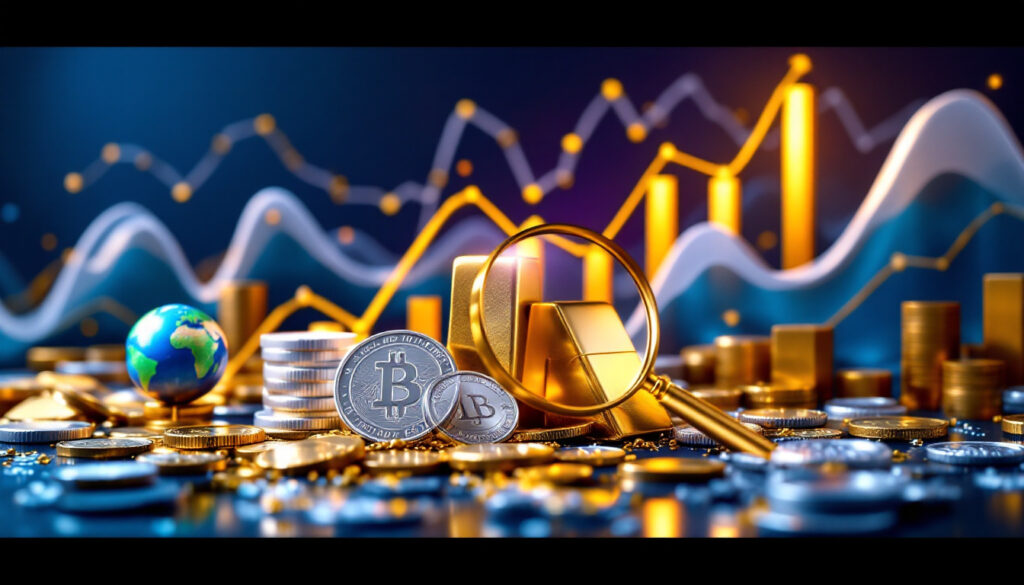What Are the Current Market Trends for Gold and Silver?
Recent Price Consolidation and Market Behavior
Gold has established itself in a strong bull market pattern, consolidating for several months – a positive technical indicator that suggests building momentum. The consolidation phase we're witnessing isn't a sign of weakness but rather a healthy pause in an ongoing uptrend. Current chart patterns and technical analysis suggest gold could potentially reach approximately $3,750 per ounce in its next significant upward movement, according to Chris Vermillion, Chief Investment Officer at Technical Traders.
Meanwhile, silver has been trading sideways in a notably tighter range than gold. This compressed trading pattern typically signals a more significant breakout potential, as pressure builds within the narrowing price channel. Technical indicators suggest silver could reach $37-38 per ounce when it finally breaks out, representing a substantial percentage increase from current levels.
"Gold is in a very strong bull market… consolidating for a couple months, which is a strong sign. Silver's tighter range suggests a bigger breakout with potential to run to $37-38." – Chris Vermillion
Understanding Capital Flow Patterns
Recent market dynamics reveal an interesting cyclical relationship between precious metals and equities. Capital has temporarily flowed away from precious metals and into equity markets, particularly technology stocks and small caps. This rotation pattern is not unusual but rather follows predictable market psychology.
When analyzing recent NASDAQ and S&P 500 rallies, we can observe this correlation in action – as equity markets surge, precious metals often experience stagnation or modest pullbacks. However, this pattern is cyclical, with capital expected to return to precious metals when stock markets begin to pull back or show signs of topping. These alternating investment cycles create strategic entry and exit opportunities for informed investors.
The key insight here is understanding that investment capital behaves like water seeking the path of least resistance toward growth. It moves between asset classes based on perceived opportunity and risk, creating predictable patterns that savvy investors can leverage.
Technical Indicators to Watch
For investors looking to time their entries and exits more effectively, several technical indicators deserve special attention:
- Volume patterns: Increasing volume during price movements confirms trend strength
- Price consolidation: Narrowing trading ranges suggest building pressure for a breakout
- Support/resistance levels: Previous price floors and ceilings often influence future movement
- Moving averages: The 50-day and 200-day moving averages provide trend confirmation
- Relative strength: Comparing performance between metals and broader markets
The consolidation patterns in both metals, particularly silver's tight trading range, suggest building pressure for future price movements. When metals break out of these patterns, the moves can be swift and significant, rewarding investors who positioned themselves before the breakout.
According to recent data from the World Gold Council, central bank gold price analysis purchases have continued at historically high levels, providing fundamental support for the technical patterns we're observing. This underlying demand creates a potential floor for prices during consolidation phases.
Why Consider Precious Metals in Your Investment Strategy?
Hedging Against Economic Uncertainty
Precious metals, particularly gold, have served as traditional hedges against various economic threats for centuries. This historical role continues to be relevant in today's complex financial landscape, where unprecedented monetary policies have created new uncertainties.
Gold provides protection against:
- Currency devaluation: As central banks expand money supply, gold often maintains purchasing power
- Inflation: Rising consumer prices typically boost gold's nominal value
- Financial system instability: During banking or credit crises, gold safe haven often outperforms paper assets
- Geopolitical tensions: International conflicts frequently drive safe-haven gold buying
As global debt levels have surged to an astounding $307 trillion (as reported by the Institute of International Finance in Q1 2025), gold and silver's role as wealth preservation tools becomes increasingly important. This debt burden represents over 360% of global GDP, creating structural vulnerabilities in the financial system that precious metals can help hedge against.
"Gold is a hedge… if currencies blow up. It's insurance for your portfolio." – Chris Vermillion
Data from the Federal Reserve Economic Data (FRED) database shows that gold outperformed most traditional assets during the 2008 financial crisis, providing crucial portfolio protection when conventional investments faltered. This historical performance underscores gold's value during periods of economic stress.
Silver's Dual Role: Investment and Industrial Metal
Silver offers a uniquely compelling investment proposition through its dual nature as both a monetary asset and an industrial commodity. This duality creates multiple demand drivers that can potentially support price appreciation:
As a monetary asset:
- Historical use as currency for thousands of years
- Store of value during economic uncertainty
- Trading patterns that often correlate with gold
As an industrial commodity:
- Essential component in electronics due to unmatched electrical conductivity
- Critical material in photovoltaic cells (solar panels)
- Growing applications in medical devices, water purification, and antimicrobial products
- Emerging uses in advanced technologies like 5G networks and electric vehicles
According to the Silver Institute, industrial applications now account for approximately 50% of annual silver demand. This industrial consumption continues to grow, particularly in green technologies. Solar panel production alone increased its silver demand by 15% year-over-year in 2024, a trend expected to accelerate as renewable energy adoption expands globally.
This dual role potentially provides silver with stronger long-term price catalysts than gold, particularly as industrial demand continues to grow with technological advancement and the global shift toward sustainable energy solutions.
Balancing Short-Term Trades vs. Long-Term Accumulation
For new investors, adopting a measured approach to investing in gold and silver is advisable. The market psychology around these assets can be challenging, with dramatic price swings triggering emotional decisions. A strategic balance between short-term opportunities and long-term accumulation creates the strongest foundation:
- Focus on gradual accumulation during price dips and consolidation periods
- Consider silver for potentially higher percentage returns in short-term market moves
- View gold primarily as a long-term wealth preservation tool rather than a vehicle for quick profits
- Develop patience and discipline to avoid emotional buying at market peaks
"Gold's not quick, easy money… a slower-moving beast. Accumulate over time… buy on days it's down." – Chris Vermillion
Historical price data from the World Gold Council shows that gold has delivered approximately 8-10% annualized returns over multi-decade periods when measured in most major currencies. While this may lag explosive stock market returns during bull markets, it significantly outperforms cash holdings over time while providing crucial diversification benefits.
How Should Beginners Approach Gold and Silver Investing?
Starting Your Precious Metals Portfolio
For those new to precious metals investing, the range of options can seem overwhelming. A methodical, step-by-step approach helps build confidence while minimizing common mistakes:
-
Begin with physical metals before exploring paper alternatives
- Start with widely recognized forms like American Eagles, Canadian Maple Leafs, or standard bars
- Focus on lower premium products initially to maximize metal content per dollar invested
- Avoid rare coins or collectibles until you understand the premium structure
-
Implement dollar-cost averaging
- Set a regular purchasing schedule (monthly or quarterly)
- Invest consistent dollar amounts regardless of price fluctuations
- This approach smooths out volatility and reduces timing pressure
-
Research secure storage options
- Home safes (affordable but limited security)
- Bank safe deposit boxes (improved security but limited access)
- Professional vaulting services (maximum security with annual fees of 0.5-1%)
- LBMA-approved facilities like SWP Cayman Islands for international diversification
-
Educate yourself continuously
- Understand spot prices versus retail premiums
- Learn to identify quality products and avoid counterfeits
- Study market cycles to recognize potential buying opportunities
Starting with small, regular purchases builds familiarity with the market while allowing you to experience the psychological aspects of metals ownership. Many investors report a different emotional relationship with physical precious metals compared to paper investments – understanding this connection helps develop a sustainable long-term approach.
Understanding the Cyclical Nature of Precious Metals
Precious metals markets move in multi-year cycles influenced by monetary policy, economic conditions, and investor sentiment. Recognizing these patterns helps investors maintain perspective during both bullish and bearish periods.
Current technical analysis suggests a potential correction in both metals over the next 6-12 months, with gold potentially pulling back 25-35% and silver possibly correcting 25-50%. While these projections represent one analyst's view, understanding that corrections are normal parts of longer-term bull markets helps prevent panic selling during downturns.
Historical precious metals cycles typically follow this pattern:
| Cycle Phase | Characteristics | Investor Strategy |
|---|---|---|
| Accumulation | Low public interest, base building, sideways price action | Steady buying, position building |
| Markup | Increasing institutional interest, technical breakouts, accelerating gains | Continue systematic buying, hold existing positions |
| Distribution | Media attention, public participation, parabolic price moves | Reduce position size, take partial profits |
| Decline | Negative sentiment, technical breakdowns, capitulation selling | Prepare capital for new accumulation phase |
Understanding where we currently sit in this cycle helps frame expectations and guide investment decisions. Most technical analysts place the gold market trends in the early-to-mid markup phase as of 2025, with significant upside potential remaining before the cycle matures.
Selecting the Right Form of Precious Metals
Investors can access precious metals through various forms, each with distinct advantages and considerations:
Physical coins and bars
- Advantages: Direct ownership, no counterparty risk, portable wealth
- Considerations: Storage requirements, insurance costs, potential premium over spot price
- Best for: Core long-term holdings and wealth preservation
Exchange-Traded Funds (ETFs)
- Advantages: Ease of trading, no storage concerns, high liquidity
- Considerations: Management fees, potential tracking errors, counterparty exposure
- Best for: Trading positions and short-term tactical allocations
Mining stocks
- Advantages: Operational leverage to metal prices, dividend potential, growth exposure
- Considerations: Company-specific risks, jurisdictional challenges, operational complications
- Best for: Growth-oriented capital seeking amplified returns during bull markets
Streaming/royalty companies
- Advantages: Exposure with reduced mining operational risk, diversified project portfolio
- Considerations: Premium valuations, competitive acquisition environment
- Best for: Investors seeking mining exposure with reduced operational volatility
Each option serves different investment objectives, and many successful precious metals investors maintain allocations across multiple categories. For beginners, physical metals provide the simplest starting point before exploring the more complex options as experience and comfort levels increase.
"Physical ownership gives you true security without counterparty risk… start there before exploring mining stocks or ETFs." – Chris Vermillion
What Factors Drive Silver's Price Relative to Gold?
Industrial Demand Growth
Silver's increasing industrial applications create substantial demand drivers beyond investment interest, differentiating its price behavior from gold. The metal's unparalleled thermal and electrical conductivity makes it irreplaceable in many high-tech applications.
Key industrial growth sectors for silver include:
- Photovoltaic (solar) cells: Each solar panel contains approximately 20 grams of silver, with limited substitution potential
- Electric vehicles: Average EV uses 25-50 grams of silver in electrical contacts and battery systems
- 5G technology: Network infrastructure requires significant silver for connection reliability
- Medical applications: Antimicrobial properties driving use in healthcare settings
According to the Silver Institute, industrial silver demand reached 508 million ounces in 2023, representing approximately half of total annual demand. The green energy transition particularly benefits silver, as it's essential in photovoltaic cells, electric vehicle components, and various electronic applications requiring high conductivity.
As governments worldwide implement policies supporting renewable energy adoption, such as the U.S. Inflation Reduction Act with its substantial clean energy subsidies, the demand outlook for silver continues to strengthen independent of its monetary role.
The Gold-Silver Ratio Analysis
The gold-silver ratio (the number of silver ounces needed to purchase one ounce of gold) provides valuable insights for investors seeking to optimize their precious metals allocations. This ratio has fluctuated dramatically throughout history:
- Pre-20th century: Often fixed by monetary authorities at ratios between 15:1 and 16:1
- Historical average (1600-2023): Approximately 60:1, according to data from Macrotrends
- Recent extremes: Reached nearly 125:1 during March 2020 market panic; has touched 30:1 during silver bull markets
| Time Period | Gold-Silver Ratio Range | Market Conditions |
|---|---|---|
| 1980s Silver Peak | Approached 15:1 | Silver bull market, Hunt Brothers influence |
| 2011 Peak | Approximately 30:1 | Post-financial crisis metals bull market |
| March 2020 | Nearly 125:1 | COVID market panic, extreme undervaluation of silver |
| Current (2025) | ~70:1 | Suggesting silver undervaluation by historical standards |
The ratio's mean reversion tendency suggests potential outperformance opportunities. When the ratio is historically high (as in early 2020), allocating more capital to silver often produces superior returns as the ratio normalizes. Conversely, when the ratio approaches historical lows, shifting some silver positions into gold may preserve gains.
This analytical tool provides strategic guidance beyond simply tracking individual metal prices, helping investors optimize their precious metals allocations based on relative value propositions.
Supply Constraints and Mining Economics
Silver production faces unique challenges that may impact future supply availability, creating potential price supports that investors should understand:
- Byproduct dominance: Approximately 70% of silver is produced as a byproduct of other metal mining (primarily lead, zinc, copper, and gold), according to the U.S. Geological Survey
- Limited primary production: Only 30% comes from primary silver mines, constraining supply responsiveness to price increases
- Declining ore grades: Average silver mine grades have fallen approximately 50% since 2000
- Inventory reduction: Above-ground silver inventories have declined substantially in recent decades, from approximately 5 billion ounces in 1980 to under 2 billion today
These supply dynamics create an interesting market structure where silver production cannot easily increase in response to higher prices. Since most silver emerges as a secondary product from mines primarily focused on base metals, production decisions often hinge on the economics of the primary metal rather than silver prices.
The environmental and regulatory challenges facing new mining projects further constrain supply growth. Permitting timelines for new mines have extended to 7-10 years in many jurisdictions, creating significant lag between price signals and production responses.
Is Market Manipulation a Concern for Precious Metals Investors?
Understanding Price Action Patterns
Many market observers note suspicious price movements in precious metals markets, particularly in silver. These patterns raise questions about market structure and potential manipulation:
- Sudden price slams: Rapid, high-volume selling during illiquid market hours
- Concentrated short positions: CFTC data occasionally shows large commercial short positions
- Technical level targeting: Price drops that precisely hit common stop-loss levels
- Paper vs. physical divergence: Periods where physical premiums disconnect from futures prices
While definitive proof of systematic manipulation is challenging to establish, these observed patterns influence market psychology and price behavior. The Commodity Futures Trading Commission (CFTC) has imposed significant penalties for manipulative trading practices in precious metals markets, including a $920 million settlement with JPMorgan in 2020 for "spoofing" and market manipulation in precious metals futures.
"Price slamming… happens all the time in individual stocks. Silver market squeeze is manipulated… but it'll have its time to shine." – Chris Vermillion
These market dynamics create both challenges and opportunities for investors. Understanding potential price suppression can help maintain conviction during seemingly irrational price declines, while also highlighting the importance of physical ownership for those concerned about paper market irregularities.
Regulatory Oversight and Market Structure
The precious metals markets operate through a complex structure of spot markets, futures exchanges, and over-the-counter trading. This complexity creates challenges for regulatory oversight and price discovery:
- Primary pricing mechanisms: The London Bullion Market Association (LBMA) and COMEX futures exchange govern approximately 90% of global gold and silver trading volume
- Over-the-counter markets: Large volumes trade privately between institutions with limited transparency
- Derivatives markets: Paper contracts representing metal value far exceed physical metal deliverability
- Regulatory bodies: CFTC oversees U.S. futures markets; FCA regulates London trading
The significant use of leverage and derivatives in these markets creates a situation where paper contracts can influence price discovery despite representing claims many times larger than available physical metal. This structure has faced criticism from market participants concerned about price suppression.
In 2023 alone, the CFTC imposed fines totaling approximately $1.2 billion for various market manipulation practices across commodities markets, including precious metals. These enforcement actions demonstrate that manipulation concerns have merit, though their systematic impact on long-term price trends remains debated among analysts
Ready to Spot the Next Major Mineral Discovery?
Discover real-time alerts on significant ASX mineral discoveries with Discovery Alert's proprietary Discovery IQ model, which transforms complex data into actionable investment insights. Visit the dedicated discoveries page to understand how major mineral discoveries can lead to substantial market returns and position yourself ahead of the market with a 30-day free trial.




